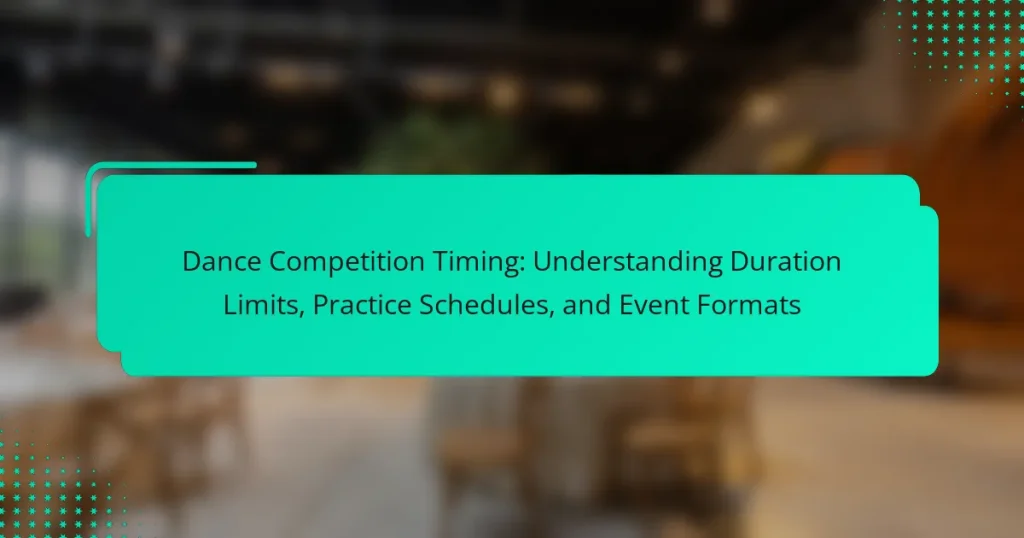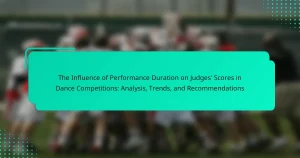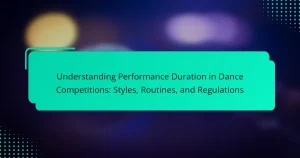Dance competition timing refers to the specific duration allocated for each performance during a dance competition, which varies by competition type and dance style. Performances typically range from one to five minutes, with solo acts often lasting one to two minutes and group routines extending up to four or five minutes. Adhering to these time limits is essential to avoid penalties and ensure the smooth flow of the event, as well as effective evaluation by judges. The article outlines the structured format of dance competitions, including categories based on dance styles and age groups, judging criteria, and best practices for managing timing to enhance performance readiness and organization.

What is Dance Competition Timing?
Dance competition timing refers to the specific duration allocated for each performance during a dance competition. Each performance typically has a set time limit, which varies by competition and dance style. For instance, solo performances may last between one to two minutes, while group routines can extend up to four or five minutes. Timing is crucial as it impacts the overall schedule of the event. Competitors must adhere to these time limits to avoid penalties. Accurate timing ensures a smooth flow of the competition and allows judges to evaluate performances effectively.
How does timing impact dance competitions?
Timing significantly impacts dance competitions by influencing performance quality and overall event flow. Precise timing ensures dancers synchronize with music and each other. Judges assess timing as a critical component of technique and artistry. Inadequate timing can result in deductions or lower scores. Furthermore, timing affects the scheduling of practice sessions and competition rounds. Efficient timing management leads to smoother transitions between performances. Competitions with strict time limits require dancers to adapt quickly. Overall, timing is essential for achieving competitive success in dance.
What are the key elements of timing in dance competitions?
The key elements of timing in dance competitions include synchronization, rhythm, and duration. Synchronization refers to the dancers’ ability to move in unison with each other and the music. This is crucial for group performances where cohesion is evaluated. Rhythm involves the dancers’ interpretation of the musical beat and their ability to match movements accordingly. Proper rhythm enhances the overall performance quality. Duration pertains to the time limits set for each performance, which can vary by competition. Adhering to these time limits is essential for compliance with competition rules. Understanding these elements is vital for dancers to achieve high scores from judges.
How does timing affect performance evaluation?
Timing significantly affects performance evaluation in dance competitions. The duration of a performance can influence judges’ perceptions of skill and execution. Short performances may limit the opportunity to showcase technical abilities. Conversely, longer performances can provide more context but may risk losing focus. Additionally, timing in practice schedules impacts dancers’ preparedness. Consistent practice leads to improved performance quality. Studies show that well-timed rehearsals correlate with higher scores in competitions. Therefore, both performance duration and practice timing are critical for effective evaluation.
What are the duration limits for dance routines?
Dance routines typically have duration limits ranging from 1.5 to 6 minutes. These limits vary based on the style of dance and the specific competition rules. For example, solo performances usually last between 1.5 to 3 minutes. Duet and group routines can extend up to 4 to 6 minutes. Major dance competitions, such as those governed by the World Dance Council, enforce these time constraints to ensure fairness and organization. Adhering to these limits is crucial for participation in competitive events.
What are the standard time limits for various dance styles?
Standard time limits for various dance styles vary by competition. For ballet, the typical performance duration is 2 to 3 minutes. In contemporary dance, routines usually last between 2 to 4 minutes. Latin dance performances often have a time limit of 1.5 to 3 minutes. For hip-hop, the standard is around 2 to 3 minutes as well. Jazz routines generally range from 2 to 3.5 minutes. These limits ensure fairness and consistency in competitions. Specific competitions may adjust these times based on their rules. Always check the event guidelines for accurate time limits.
How do duration limits vary by competition level?
Duration limits in dance competitions vary significantly by competition level. Beginner competitions often have shorter duration limits, typically ranging from 1 to 2 minutes. Intermediate levels may extend these limits to 2 to 3 minutes. Advanced competitions usually allow performances lasting 3 to 4 minutes. These variations are designed to accommodate the skill levels of participants. For instance, shorter durations for beginners help focus on basic techniques. In contrast, advanced dancers are expected to showcase more complex choreography within longer durations. This structure supports a progressive skill development framework in dance competitions.
What factors influence practice schedules for dance competitions?
Practice schedules for dance competitions are influenced by several factors. These include the competition date and time, which dictate how much time dancers have to prepare. The number of routines being performed also affects scheduling, as more routines require additional practice time. The skill level of the dancers plays a role; advanced dancers may need less practice than beginners. Availability of rehearsal space is another critical factor, as limited access can constrain practice times. Additionally, the choreography complexity impacts how much time is needed for effective practice. Lastly, the dancers’ physical condition can influence their ability to practice consistently and effectively.
How can dancers effectively manage their practice time?
Dancers can effectively manage their practice time by creating a structured schedule. A well-planned timetable includes specific practice sessions for technique, choreography, and conditioning. Prioritizing practice goals helps dancers focus on areas needing improvement. Setting time limits for each practice segment encourages efficiency. Utilizing tools like timers can enhance focus during practice. Regularly reviewing progress allows for adjustments in the practice plan. Research indicates that structured practice leads to better skill acquisition and retention. A study by Ericsson et al. (1993) emphasizes that deliberate practice significantly improves performance in dance and other disciplines.
What role does choreography play in practice scheduling?
Choreography plays a crucial role in practice scheduling for dance competitions. It determines the structure and flow of the performance. A well-designed choreography requires specific time allocations for each section. This ensures that dancers practice transitions and formations effectively. Scheduling must account for the complexity of the choreography. More intricate routines may require longer practice sessions. Additionally, choreography influences the timing of rehearsals leading up to the competition. Proper scheduling allows for adequate repetition and refinement of movements. This ultimately enhances performance quality during the competition.

How are dance competition events formatted?
Dance competition events are typically formatted into categories based on dance styles and age groups. Each category features a set number of performances by participants. Competitors perform routines that are judged on various criteria, including technique, artistry, and overall performance. Events usually have a schedule that outlines the order of performances. Each routine has a specific time limit, often ranging from one to five minutes. Judges score routines on a numerical scale, and awards are given based on these scores. This structured format ensures fairness and organization during competitions.
What are the common formats for dance competitions?
Common formats for dance competitions include solo, duo, trio, and group categories. Each format allows dancers to perform in varying numbers. Solo competitions feature individual performances. Duo and trio formats involve two or three dancers, respectively. Group categories typically consist of four or more dancers. Additionally, competitions may be categorized by dance style, such as ballet, hip-hop, or jazz. Some competitions also have specific age divisions. These formats help structure events and accommodate different levels of participants.
How do different formats affect participant experience?
Different formats significantly influence participant experience in dance competitions. Each format can alter the level of engagement and performance pressure. For example, solo performances allow for individual expression, while group formats foster teamwork. Research shows that participants in team formats report higher satisfaction due to shared experiences. Conversely, solo formats may create increased anxiety due to the spotlight effect. The structure of the competition, whether it is a single elimination or round-robin format, also impacts participant stress levels and enjoyment. Studies indicate that well-structured formats enhance overall satisfaction and performance outcomes.
What are the pros and cons of each competition format?
Each dance competition format has distinct pros and cons. The solo format allows for individual expression and showcases personal talent. However, it can create pressure on the dancer to perform alone. The duo format fosters teamwork and collaboration, enhancing connection. Yet, it may limit individual performance visibility. Group formats promote camaraderie and collective creativity. Conversely, they can dilute individual recognition. The team format encourages unity and shared goals, but can lead to competition for attention among members. Each format’s effectiveness varies based on dancer preferences and goals.
What is the role of judges in timing during competitions?
Judges play a crucial role in timing during competitions. They are responsible for ensuring that each performance adheres to the designated time limits. This involves accurately tracking the duration of each routine. Judges use timing devices to measure performance lengths precisely. They also enforce penalties for performances that exceed time limits. Accurate timing is essential for maintaining the competition schedule. Judges must remain attentive and focused throughout each performance. Their timing decisions impact scoring and overall competition outcomes.
How do judges assess timing and duration in performances?
Judges assess timing and duration in performances by evaluating the synchronization of movements with music and the overall flow of the routine. They observe whether dancers start and end their routines within the allotted time limits. Judges also look for the precision of timing in executing specific choreography. Accurate timing enhances the visual impact of the performance. Additionally, judges consider how well the performance maintains a consistent tempo throughout. They may utilize timing devices to measure exact durations during competitions. This systematic approach ensures fairness and consistency in scoring across performances.
What criteria do judges use to evaluate timing?
Judges evaluate timing based on synchronization, rhythm, and adherence to required duration. Synchronization refers to how well dancers coordinate their movements with the music. Rhythm involves matching the tempo and beats of the music accurately. Adherence to duration means performances must fit within specified time limits. These criteria ensure that performances are executed as intended and maintain the integrity of the dance style. Judges often use a scoring rubric that quantifies these aspects during evaluations.
How can dancers prepare for timing requirements in competitions?
Dancers can prepare for timing requirements in competitions by practicing consistently with a metronome. A metronome helps them develop a strong sense of rhythm. They should also time their routines to ensure they fit within competition limits. Recording practice sessions allows dancers to review their timing accuracy. Additionally, they can participate in mock competitions to simulate the event environment. Collaborating with instructors for feedback on timing is crucial. Understanding the specific timing rules of each competition enhances their preparation. Regularly revisiting choreography helps maintain timing consistency.
What strategies can dancers use to improve timing accuracy?
Dancers can improve timing accuracy through consistent practice, rhythmic training, and using a metronome. Consistent practice helps reinforce muscle memory and enhances coordination. Rhythmic training develops a dancer’s ability to internalize beats and musical phrasing. A metronome provides a steady tempo for dancers to synchronize their movements. Additionally, recording and reviewing performances can highlight timing issues. Working with a choreographer offers external feedback on timing precision. Group practice sessions foster synchronization with other dancers. Lastly, mindfulness techniques can enhance focus on timing during performances.
How can dancers practice under competition conditions?
Dancers can practice under competition conditions by simulating the actual performance environment. This includes adhering to time limits set for their routines. Dancers should also practice in full costume and makeup to get accustomed to their appearance. They can perform in front of peers or coaches to receive constructive feedback. Recording practice sessions allows dancers to review their performances critically. Additionally, incorporating warm-up and cool-down routines can help mimic the competition schedule. Practicing in the venue, if possible, familiarizes dancers with the space and acoustics. These strategies enhance confidence and performance readiness for actual competitions.

What are best practices for managing timing in dance competitions?
Best practices for managing timing in dance competitions include strict adherence to schedule, effective communication, and time management training. Dancers should arrive early to warm up and prepare. Organizers must ensure that all participants are aware of time limits for performances. Utilizing timers and cues can help dancers stay on track during routines. Regular practice sessions should incorporate timing drills to enhance performance readiness. Additionally, clear signage and announcements can keep everyone informed about the competition flow. These practices help maintain a smooth event and ensure that all performances fit within the designated time slots.
How can dancers ensure they meet timing requirements?
Dancers can ensure they meet timing requirements by practicing consistently and using a metronome. Consistent practice helps dancers internalize rhythms and timing. A metronome provides a steady beat for dancers to follow. Dancers should also record their performances to evaluate timing accuracy. Analyzing recordings highlights areas needing improvement. Additionally, dancers can break routines into sections to focus on timing in smaller segments. This method allows for targeted practice on challenging parts. Attending rehearsals with other dancers can enhance timing through group synchronization. Engaging with instructors for feedback further refines timing skills.
What tools and techniques can assist in timing management?
Tools and techniques that assist in timing management include digital timers, scheduling apps, and time-blocking methods. Digital timers provide precise tracking of performance durations. Scheduling apps like Google Calendar help organize practice sessions effectively. Time-blocking methods allocate specific time slots for tasks, enhancing focus. Utilizing a stopwatch during rehearsals ensures adherence to time limits. Additionally, choreographers can implement countdown timers during practices to simulate competition conditions. These tools collectively enhance time efficiency and preparation accuracy in dance competitions.
How can dancers troubleshoot common timing issues?
Dancers can troubleshoot common timing issues by practicing with a metronome. A metronome provides a steady beat that helps dancers maintain consistent timing. Dancers should also record their practices to identify timing discrepancies. Listening to these recordings allows for self-assessment and adjustment. Additionally, working with a partner can help synchronize movements. A partner can provide feedback on timing and coordination. Regularly attending classes enhances timing skills through structured guidance. Finally, focusing on muscle memory through repetition solidifies timing accuracy. These methods are effective in improving overall timing in dance routines.
Dance Competition Timing is a critical aspect of dance competitions, encompassing the specific duration allocated for each performance, which varies by competition and dance style. This article provides an overview of timing’s impact on performance quality, key elements of timing such as synchronization and rhythm, and the duration limits for various dance routines. Additionally, it explores practice schedules influenced by competition factors, the formatting of dance events, and the role of judges in evaluating timing. Best practices for managing timing and strategies for dancers to improve timing accuracy are also discussed, ensuring effective preparation for competitive success.




